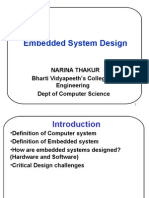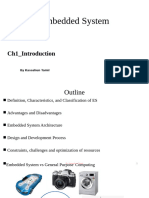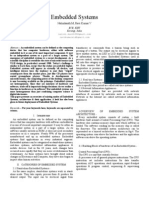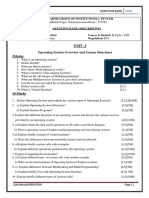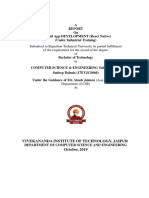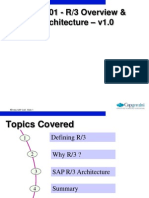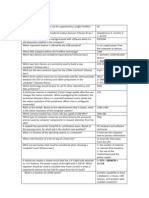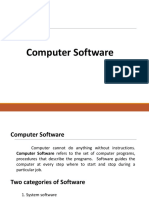Five Mark Questions (2 Pages Each)
1. Explain the key components of an embedded system with examples.
Embedded systems consist of both hardware and software components, each performing specific
functions. The major hardware components are:
1. Processor: It is the core unit responsible for executing instructions and managing tasks. It can be a
microcontroller or microprocessor. Example: ARM Cortex-M3 used in smart appliances.
2. Memory: Used to store data and program code. RAM, ROM, Flash are common types.
3. Input Devices: Sensors, switches, or buttons that send signals to the processor.
4. Output Devices: LEDs, displays, buzzers, or actuators that receive signals from the processor.
5. Communication Interfaces: Used for data transfer, including UART, SPI, I2C.
6. Timers and Counters: Essential for real-time applications, handling delays or counting events.
Example: In a digital camera, components include image sensor (input), LCD (output), processor for image
processing, and memory to store pictures.
2. Differentiate between general-purpose processors and application-specific processors.
General-purpose processors (GPPs) are designed for versatility and can handle multiple applications.
Application-specific processors (ASPs) are tailored to perform dedicated functions within a system.
Comparison Table:
Feature General-Purpose Processor Application-Specific Processor
Use Multipurpose tasks Specific application
Cost Generally high Optimized for cost
Performance Moderate High for specific task
Examples Intel Core i5, AMD Ryzen DSPs, ARM Cortex-M, ASICs
Power Usage Higher Lower, optimized
GPPs are ideal for PCs and laptops, while ASPs are commonly used in washing machines, microwave ovens,
or medical devices where performance, cost, and power need optimization.
3. Illustrate the design process of an embedded system with a suitable example.
The embedded system design process consists of several structured steps:
1. Requirement Analysis: Understanding the user needs and system constraints.
2. Specification: Documenting hardware/software requirements.
3. Architecture Design: Creating block diagrams to show system components.
4. Partitioning: Assigning tasks to hardware or software.
1
� 5. Implementation: Actual coding and hardware construction.
6. Testing and Debugging: Ensuring functionality and performance.
7. Deployment: Installing the final product.
Example: Smart Door Lock System
• Uses RFID input, microcontroller as processor
• Controls a solenoid lock (output)
• Includes memory for storing access logs
• Tested for reliability and security before deployment
4. Describe the characteristics of complex systems and their processors.
Complex embedded systems possess multiple functionalities and require advanced processing capabilities.
Their characteristics include:
• Multitasking Support: Run several operations simultaneously.
• Real-time Processing: Time-sensitive responses.
• High Processing Power: Due to intensive computations.
• Peripheral Interfaces: Multiple sensors and actuators.
• Memory Management: Efficient memory utilization.
Processors for complex systems:
• ARM Cortex-A series (e.g., in smartphones)
• PowerPC (used in avionics)
• DSPs for image/signal processing
Such processors support operating systems like Linux or Android and are capable of complex computations
such as data encryption, machine learning, or multimedia processing.
5. Write a short note on embedded software in a system.
Embedded software is the control program written to run on embedded hardware. It includes:
• Application Layer: Manages system-specific functionality.
• Middleware: Handles communication, protocol stacks.
• Device Drivers: Interface with hardware peripherals.
• Real-Time Operating System (RTOS): Ensures multitasking and real-time performance.
Written typically in C or assembly, embedded software is optimized for speed and size. It is stored in non-
volatile memory like ROM or Flash. Examples include the code in traffic light controllers, firmware in
printers, or control logic in industrial robots.
Ten Mark Questions (4 Pages Each)
1. Discuss the classification of embedded systems in detail with examples.
2
�Embedded systems are classified based on functionality, performance, and system requirements. The major
classifications are:
1. Standalone Embedded Systems These systems work independently without needing a host system.
2. Example: Washing machines, microwave ovens, calculators
3. Characteristics: Take input, process it internally, and produce output
4. Real-Time Embedded Systems Designed to perform tasks within strict timing constraints.
5. Hard Real-Time Systems: Missing a deadline may lead to disaster (e.g., airbags, medical life-
support)
6. Soft Real-Time Systems: Occasional delay is acceptable (e.g., multimedia streaming)
7. Characteristics: Deterministic response, precise timing
8. Networked Embedded Systems These systems are connected via a network to share data or
coordinate actions.
9. Example: Smart meters, networked surveillance cameras
10. Characteristics: Use of protocols like TCP/IP, real-time communication
11. Mobile Embedded Systems Small, battery-powered devices with mobility features.
12. Example: Smartphones, fitness trackers, GPS units
13. Characteristics: Power efficient, small size, often run on mobile OS
14. Media Embedded Systems (Optional extension) Focused on audio/video processing.
15. Example: Smart TVs, media players
16. Require high-speed data processing and multimedia interfaces
Each classification targets a unique set of applications and design constraints. Real-time systems focus on
deadlines, networked systems on communication, and mobile systems on power and portability.
2. Explain the embedded system design process with a flowchart and an example.
The embedded system design process is a structured series of steps aimed at creating functional, efficient,
and reliable systems. It includes:
1. Requirement Analysis: Define the functionality, environment, constraints
3
� 2. Specification: Document all required hardware/software features
3. Architecture Design: Develop a block-level diagram
4. Partitioning: Decide what will be implemented in hardware or software
5. Hardware and Software Design: Create circuit diagrams and code modules
6. Integration and Testing: Combine modules and verify performance
7. Validation and Deployment: Final test and install in the real environment
Flowchart:
Requirements → Specification → Architecture → Partitioning → Design →
Integration → Testing → Deployment
Example: Automatic Plant Watering System
• Inputs: Soil moisture sensor, clock timer
• Controller: Microcontroller (e.g., Arduino)
• Output: Water pump controlled via relay
• Process: Measures moisture; activates pump if dry
• Result: Automated irrigation, saving time and water
3. Analyze the hardware and software units of an embedded system.
Hardware Units:
1. Processor: Microcontroller or microprocessor to control operations
2. Memory: Stores data and instructions (RAM, ROM, EEPROM)
3. Input Devices: Sensors (e.g., temperature, pressure)
4. Output Devices: Actuators, displays, buzzers
5. Timers/Counters: For delay generation or event counting
6. Communication Interfaces: For inter-device data exchange (I2C, SPI, CAN, USB)
7. Power Supply: Converts voltage levels, includes battery or AC adapter
Software Units:
1. Application Software: Custom logic for the device
2. Device Drivers: Low-level code to interact with hardware
3. Middleware: Manages data communication or OS services
4. RTOS (optional): Enables multitasking, real-time performance
5. Bootloader: Initializes the system on power-up
Example: In a smart thermostat:
• Hardware: Temp sensor (input), relay (output), MCU (processor), Wi-Fi module
• Software: Code for temperature control, user interface, connectivity
Together, the hardware performs sensing and actuation, while the software manages logic, control, and
user interaction. Successful embedded systems optimize both for speed, reliability, and power usage.






